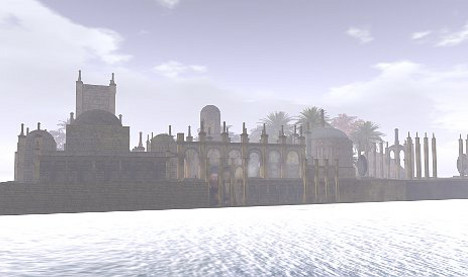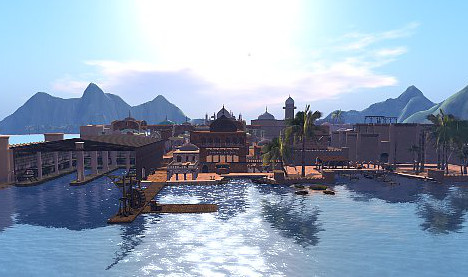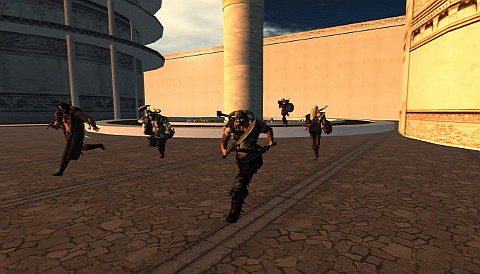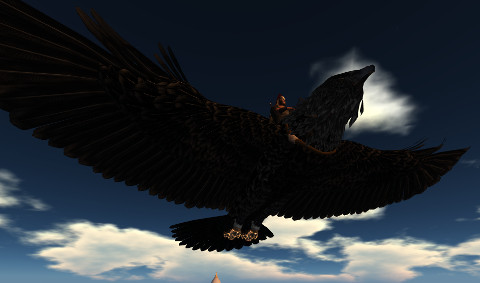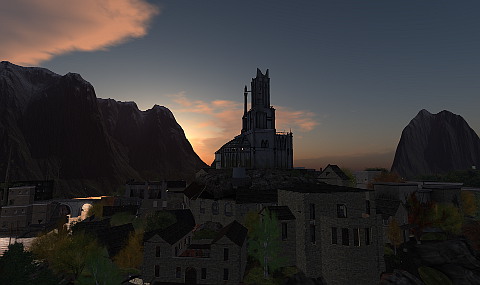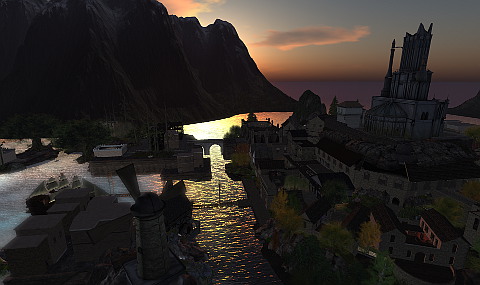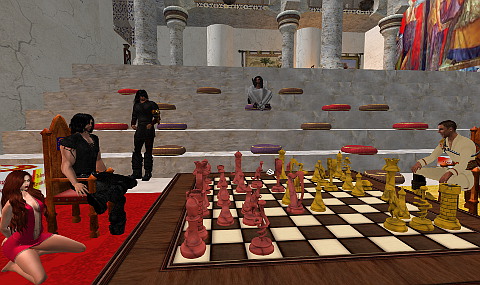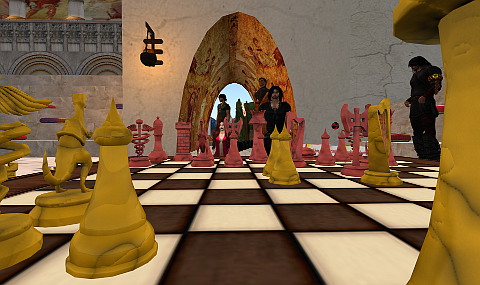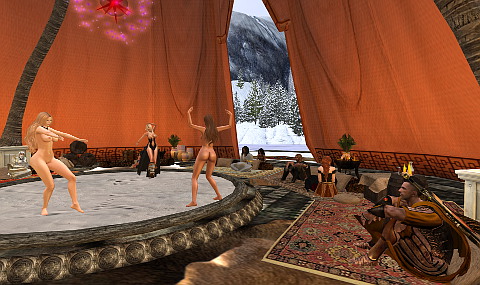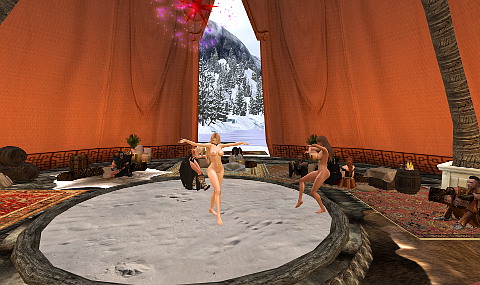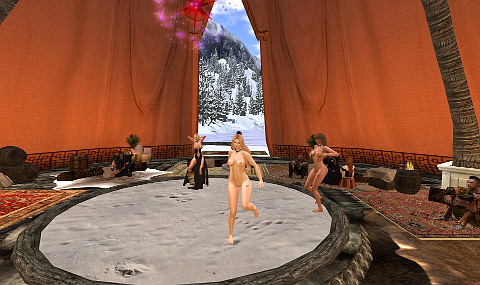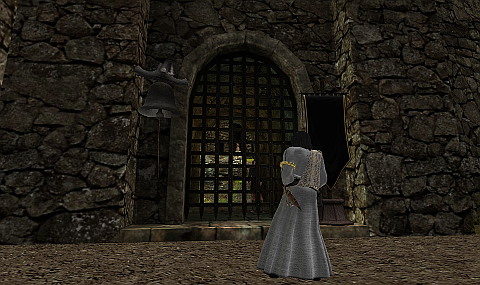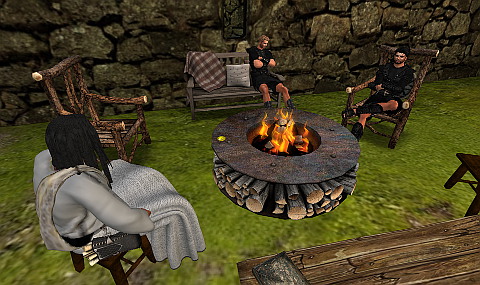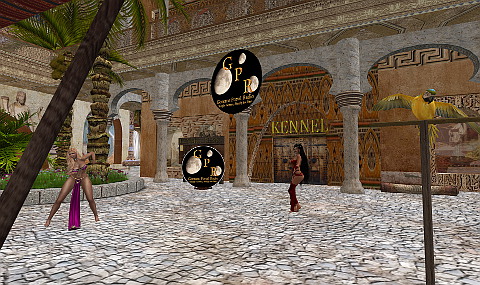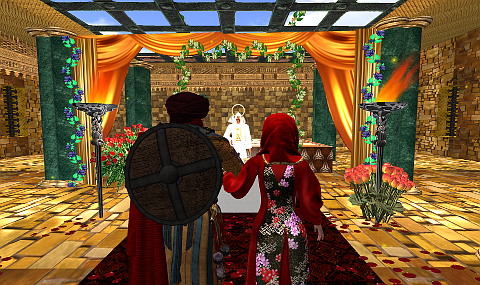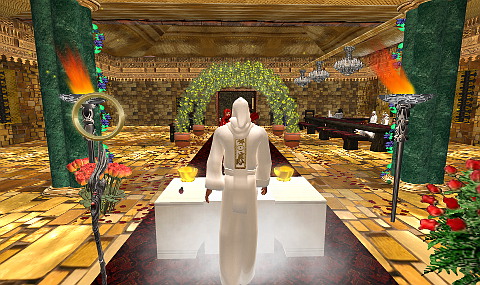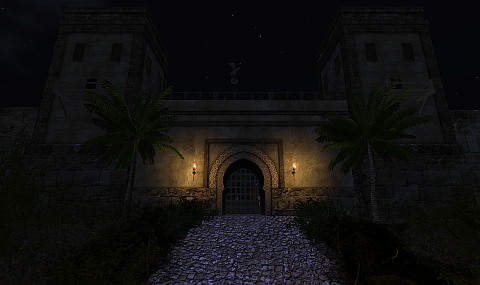Archive for the ‘Miscellaneous’ Category
They are upon you!
Saturday, February 8th, 2020Torvaldslanders attacking Olni in Saleria!
The Most Common Onlinisms
Sunday, October 13th, 2019[Taken from the VOICE OF GOR Seventh volume (year), issue No. 326]
by Oisin, head Physician of Kasra – Fayeen
Torvaldslanders did not speak Danish, Norwegian, Swedish or any other Scandic language – they only spoke Gorean
It is also believed that the Pani spoke Japanese – not only is that NOT in the books, it actually says (in Swordsmen of Gor) that anyone who did use Japanese was killed by blue flame: “We must learn their language or be destroyed,” said Lord Nishida. “Some recalcitrants and zealots were consumed by fire, streaming from the sky.” Again (apart from titles used, which wouldn’t exist in Gorean, no Japanese words were used – they also ONLY used ‘Tal’ to greet.
Apart from people living in the far north, Goreans did not wear trousers but robes or tunics with sandals – they certainly didn’t have cargo pants and combat boots. Generally caste colours were worn (they liked colourful outfits). The only people who would dress in black would be assassins. Obviously, tarnsmen (which is not a caste or even a sub-caste and is anyone flying a tarn and not restricted to warriors) would have protective clothing while flying as would anyone riding a tharlarion (they wore thigh high boots as protection). When not fluing or riding, they weore normal Gorean clothes. Pirates did NOT run round with tricorne hats, eye patches or wooden legs – they dressed like ordinary Goreans (and didn’t talk like bad Johnny Depp impersonators either).
Not all Goreans ran round carrying weapons. Warriors carried a short sword, similar to the Roman gladius. There was a longer sword (similar to the Roman calalry spatha) used by riders of the high tharlarion. Apart from the Pani, they did not use a ka ta na (and were very unlikely to acquire one). As far as SL goes, all swords cause equal damage and are equal in range, so why do people run round with some extremely strange looking weapons? As far as bows are concerned, thew ONLY time a warrior would use one would be while flying a tarn (and it would be a crossbow and not a longbow). Guardsman (who were NOT members of the warrior caste – only their officers were) would have crossbows (it is easier to lean to point and squeeze than it is to use a sword or a longbow). They also did NOT wear armour:
“…I would have supposed that armor, or chain mail perhaps, would have been a desirable addition to the accouterments (sic) of the Gorean warrior, but it had been forbidden by the Priest-Kings….”
“…Incidentally, speaking of the crossbow and longbow, I did receive some instruction in them, but not much. The Older Tarl, my redoubtable instructor in arms, did not care for them, regarding them as secondary weapons almost unworthy for the hand of a warrior….” Later on it’s stated that the only armour was a Greek style helmet and a shield – no greaves, breastplates, backplates, caudrons or anything else. Goreans were not Roman warriors.
Goreans were xenophobic – remember that the word for ‘stranger’ was also the word for ‘enemy’. Additionally, Gor was a very big place. It took Tarl weeks to travel to places like Schendi, the Barrens, Turia, etc. People didn’t waltz down on an overnight trip and companion one of the locals. They were more likely to end up dead or collared in a mine, never mind having children who visited relatives at the opposite ends of Gor on a day trip. The strangestone is people who claim to be ‘Mamba’. Mamba isn’t a race or a tribe – it’s the Ushindi word for a cannibal. Anyone who thinks one of their parents is a Mamba is sadly delusional – they would have had the other parent for dinner instead of having their offpring.
Regarding place names. While I can see the point in some non-Gorean placenames, using something just ‘because it’s in the book’ isn’t really a good idea. A couple of examples would be ‘Lar Torvis’ – that’s the Sun and nobody lives there. ‘Axe Fiord’ – Axe is a glacier and nobody in their right mind is going to found a village on a sheet of moving ice. Using names like ‘Pembe’ or ‘Iskander’ is odd – those were PEOPLE and not places. There are plenty of names in the books that seem to be unused, so why invent ones?
Gorean ships were closer in appeance to 15/16th century galleys with lateen (triangular) sails and oar banks with a ram at the prow. They were NOT 17th century square riggers.
Rest in Piece, Goreans!
Friday, January 18th, 2019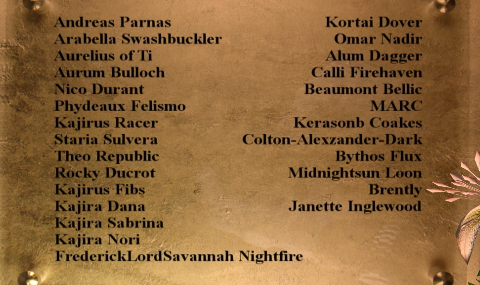
Genesian Port
Friday, October 26th, 2018Kaissa Tournament in Ianda
Sunday, January 7th, 2018Playing: DarkFire, Ambassador of the Kaissa Guild of Gor, versus Kjerulf, caste of players. Darkfire won.
1) Introduction: what is the Kaissa?
Kaissa is the Gorean word for “game”. It is a general term that can refer to any type of game but when it is used without qualification, it means only one game, Gorean chess. This is a game very similar to Earth chess though there are numerous differences as well. Kaissa is a very popular game and almost all civilized Goreans, of whatever caste, play. There are many Kaissa clubs and competitions. Lists of important competitions and tournaments are commonly kept in each city’s Cylinder of Documents. Most city libraries have many scrolls of Kaissa strategy and techniques.
Kaissa uses a red and yellow hundred-squared board, with ten ranks and ten files. This is opposed to the normal Earth chessboard of sixty-four squares with eight ranks and files. In Kaissa, there are twenty-two pieces to each side as opposed to sixteen in Earth chess. One side is yellow and the other is red.
Kaissa is played differently throughout Gor. Some cities use different pieces or similar pieces with different abilities. Eventually most cities accepted standard tournament rules, helping to unify and standardize play. These rules were agreed upon by the High Council of the Caste of Players and officially promulgated by the Merchant Caste in 10124 C.A. at the En’Kara fair. Standardized Kaissa may also be known as Merchant Kaissa, Player Kaissa or Kaissa of the En’Kara. Unfortunately, though much information is given about the game, the novels do not provide a complete set of rules for playing Kaissa.
In Torvaldsland, they play their own version of Kaissa. They have a great passion for the game, even greater than those in the south. They sometimes settle disputes over the Kaissa board rather than with weapons. Some pieces differ in their game. The Jarl, their most powerful piece and the Jarl’s Woman, more powerful than the Ubara, are used instead of an Ubar and Ubara. Instead of Tarnsmen there are two Axes. They have no Initiates but have Rune-Priests. They do not have Scribes but have a piece, the Singer, which moves similarly. Their Spearmen move identically as in the southern game. Instead of a Home Stone, there is a Lodge.
Slaves are not commonly permitted to play Kaissa. It is even illegal in some cities for slaves to play or even touch the pieces without permission. They could lose their hands or even be killed for such a violation. Free women also seem not to play Kaissa though there is no explicit prohibition in the books stating that they may not play. Assassin of Gor does make a brief reference that women do not play the game.
2) Southern version: the pieces
Ubar:
The Ubar is the most powerful piece on the board, and is situated on the back row. It can move, on the board, as far as the Player likes in any direction, so long as its way is not impeded by another piece.
Its loss does not constitute the end of the game, this only happens when the Homestone is taken.
Ubara:
The Ubara, situated on the back row on a square of her own colour, moves almost the same way as the Ubar, except for the fact that it is restricted to three squares in any direction, as long as it is not impeded by another piece in its way.
Tarnsman:
The Tarnsman, of which there are two, is another back row piece, and is the Ubar’s most probable right hand man. Its moves are three squares up and two over in any direction. These moves allow the Tarnsman to go over or around another piece, and to capture any piece belonging to an opponent.
The Tarnsman can also move one square in any direction, these moves do not allow it to capture any other piece.
Scribe:
The Scribe, two to each side, sit on the back row. It moves diagonally on its own colour in both directions, but is limited to five squares, as long as no one impedes its progress.
Builder:
The Builder, two per player, is another back row piece. It moves forward, backward and laterally in both directions, with no limit to the number of squares, so long as no one impedes its progress.
Initiate:
The Initiate is one of two pieces per player on the back row. It too, like the Scribe, moves diagonally, but has no limits to how many squares he can move, so long as its way is not impeded by another piece.
Spearman:
The Spearman is one of six each side, and is the main front row piece. It moves forward only and captures only on the diagonal. On the first move, the Spearman has the option of moving either one, two or three squares forward. After the Spearman’s first move it advances only one square at a time. A Spearman can be redeemed for another piece, either the Rider of the High Tharlarion or the Tarnsman: this happens when it has reached the opponent Player’s first rank and can move no further forward.
Rider of the High Tharlarion:
The Rider of the High Tharlarion is one of two pieces per player, and it flanks the six Spearmen on the front row. The Riders can move one square in any direction, as long as they are not impeded by another piece.
Assassin:
The Assassin, two per player, flank the two Riders of the High Tharlarion on the front row. The Assassins can move two squares in any direction forward, backward, laterally or diagonally, so long as they are not impeded by another piece.
Homestone:
The Homestone is the most important piece of the game. It does not start on the board, but each Player must place it on the board by the tenth move. The placement of the Homestone constitutes a movement on its own. If the Homestone isn’t placed on or before the tenth move, the game is over and the other Player will win the match. The aim of the game is to take your opponent’s Homestone without losing your own. The game is over when one or the other Homestone is taken, or one Player resigns, or a draw is accepted. The Homestone has the ability to move one square in any unimpeded direction. It does not, however, have the right to capture other pieces. The placement of the Homestone on the board is your own and your opponent’s choice. The Homestone must be placed on the first rank of one’s playing field, but it cannot be placed on an already occupied square.
3) Northern version: the pieces
Northern version is the Torvaldsland variation of the Southern Kaissa, where some of the pieces have different names and one (the Jarl’s Woman) is more powerful than the Southern version.
Here is a list of the different pieces between Northern and Southern versions:
– Jarl instead of Ubar
– Jarl’s Woman instead of Ubara (Jarl’s Woman is restricted to five cells in any direction, while Ubara is restricted to three)
– Axe instead of Tarnsman
– Singer instead of Scribe
– Rune Priest instead of Initiate
– Physician instead of Assassin
– Lodge instead of Homestone
The Fair of Se’Var
Friday, January 5th, 2018“The fairs incidentally are governed by Merchant Law and supported by booth rents and taxes levied on the items exchanged. The commercial facilities of these fairs, from money changing to general banking, are the finest I know of on Gor, save those in Ar’s Street of Coins, and letters of credit are accepted and loans negotiated, though often at usurious rates, with what seems reckless indifference. Yet perhaps this is not so puzzling, for the Gorean cities will, within their own walls, enforce the Merchant Law when pertinent, even against their own citizens. If they did not, of course, the fairs would be closed to the citizens of that city.”
(“Priest-Kings of Gor” page 11)
“It is little wonder then that the cities of Gor support and welcome the fairs. Sometimes they provide a common ground on which territorial and commercial disputes may be amicably resolved without loss of honor, plenipotentiaries of warring cities having apparently met by accident among the silken pavilions.
Further, members of castes such as Physicians and Builders use the fairs for the dissemination of information and techniques among Caste Brothers, as is prescribed in their codes in spite of the fact that their respective cities may be hostile. And as might be expected members of the Caste of Scribes gather here to enter into dispute and examine and trade manuscripts.”
(“Priest-Kings of Gor” page 9)
“The fairs, too, however, have many other functions. For example, they serve as a scene of caste conventions, and as loci for the sharing of discoveries and research. It is here, for example, that physicians, and builders and artisans may meet and exchange ideas and techniques. It is here that Merchant Law is drafted and stabilized. It is here that songs are performed, and song dramas. Poets and musicians, and jugglers and magicians, vie for the attention of the crowds. Here one finds peddlers and great merchants. Some sell trinkets and others the notes of cities. It is here that the Gorean language tends to become standardized. These fairs constitute truce grounds. Men of warring cities may meet here without fear. Political negotiation and intrigue are rampant, too, generally secretly so, at the fairs. Peace and war, and arrangements and treaties, are not unoften determined in a pavillion within the precincts of the fairs.”
(“Beasts of Gor” page 44)
Court of Assassins
Wednesday, December 20th, 2017My men,” said the captain, “went to the Court of Assassins in Brundisium. Two had been hired, but they did not report back.”
“Nor will they,” said the stranger.
“That is known to me,” said the captain. “Their bodies were washed ashore.”
“You are in danger,” I said to the stranger. “The Assassins will come to avenge their own.”
“No,” said the captain, “at least not those of the Court of Brundisium, unless more coin is put forth. Vendetta is not their way. Their fellows took fee and failed to earn it. They are not to be avenged. They failed. They are disgraced. They are no longer of the Court.”
“Cineas,” said the stranger, “may not even know they failed.”
“He must know,” I said.
“In any event,” said the captain, “my men, amongst whom is Tatsu, perhaps known to Callias, for he was on the great ship, arranged certain matters with the Court of Assassins.”
“I know him,” said the stranger.
“What matters?” I asked the captain.
“Two of the black caste were hired to seek out Cineas, and slay him,” said the captain. “I do not think they have yet found him.”
“What was the fee?” asked the stranger.
“A silver tarsk, each,” said the captain.
(Mariners of Gor, Pages 501 – 502)
Goreans Portal Radio broadcasting!
Thursday, November 16th, 2017Goreans Portal Radio broadcasting from the main plaza of Ianda!
Free Companionship Ceremony
Thursday, November 16th, 2017Free Companionship Ceremony of Nephtides na Neidos and Lady Belle from Teehra held by Serus, Initiate of Ianda.
The Gates of Kasra – Fayeen
Saturday, November 4th, 2017The gates of Kasra – Fayeeen river by night.
